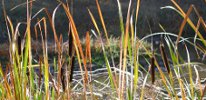
Archived Workshops/References
Serpentine Grasslands
Description
Many rare grassland species are found mainly on serpentine soils. The Coastal Training Program is working to bring together scientists, stewards, consultants, and regulatory agencies to explore conservation solutions. Serpentine grasslands have long been oases of grassland species diversity in an increasing desert of exotic invasive plant species. An interesting chemistry and physical makeup of serpentine soils has either thwarted invading species or reduced their impacts so that native grassland species, some of which are now found only on serpentine soils, flourish. The most extensive serpentine grasslands in our region are found near San Jose, in Santa Clara County California. Fortunately, there is a wealth of research in this geographic area that has added greatly to our understanding of serpentine grasslands and the management dilemmas that the conservation community faces in preserving them. The current focus of the Coastal Training Program has been to highlight work by Dr. Stuart Weiss on the potential impacts of vehicle emission-originated Nitrogen, which he has documented being deposited on the serpentine grasslands. Dr. Weiss' work has helped us understand the role that grazing plays in mediating the impacts of Nitrogen deposition, which would otherwise pose a significant threat to the Bay Checkerspot butterfly (Euphydryas editha bayensis) by favoring exotic invasive grasses that out compete the butterfly's host plants. On this web site, you'll find notes, photos, and resources that can help you to better understand serpentine grasslands and Dr. Weiss' work. If you have questions or suggestions for further information that we might provide, please contact us.
Training Programs
Documents and Publications
| TITLE DATE ADDED |
AUTHOR SOURCE |
DESCRIPTION |
|---|---|---|
| PEER-REVIEWED PUBLICATIONS | ||
| Cars, cows, and checkerspot butterflies: nitrogen deposition and management of nutrient-poor grasslands for a threatened species. PDF, 2.8MB Jun 30 05 |
Weiss, S.B. Conservation Biology 13(6): 1476-1486 1999 |
|
| Ecological Effects of Nitrogen deposition in the Western United States. PDF, 730KB Jun 30 05 |
Mark E. Fenn, Jill S. Baron, Edith B. Allen, Heather M. Rueth, Koren R. Nydick, Linda Geiser, William D. Bowman, James O. Sickman, Thomas Meixner, Dale W. Johnson, and Peter Neitlich BioScience 53(4):404-420 2003 |
|
| Nitrogen emissions, deposition, and monitoring in the Western United States. PDF, 865KB Jun 30 05 |
Mark E. Fenn, Richard Haeuber, Gail S. Tonneson, Jill S. Baron, Susanne Grossman-Clarke, Diane Hope, Daniel A. Jaffe, Scott Copeland, Linda Geiser, Heather M. Rueth, and James O. Sickman. BioScience 53(4):391-403 2003 |
|
| OTHER INFORMATION | ||
| Photo 1: Coyote Ridge Serpentine Grasslands Field Trip JPG, 210KB Jun 30 05 |
Mark Stromberg Elkhorn Slough Coastal Training Program 2005 |
|
| Photo 2: Coyote Ridge Serpentine Grasslands Field Trip JPG, 124KB Jun 30 05 |
Mark Stromberg Elkhorn Slough Coastal Training Program 2005 |
|
| Photo 3: Coyote Ridge Serpentine Grasslands Field Trip JPG, 199KB Jun 30 05 |
Mark Stromberg Elkhorn Slough Coastal Training Program 2005 |
|
| Photo 4: Coyote Ridge Serpentine Grasslands Field Trip JPG, 230KB Jun 30 05 |
Mark Stromberg Elkhorn Slough Coastal Training Program 2005 |
|
| Photo 5: Coyote Ridge Serpentine Grasslands Field Trip JPG, 125KB Jun 30 05 |
Mark Stromberg Elkhorn Slough Coastal Training Program 2005 |
|
| Photo 6: Coyote Ridge Serpentine Grasslands Field Trip JPG, 135KB Jun 30 05 |
Mark Stromberg Elkhorn Slough Coastal Training Program 2005 |
Links
| TITLE | DATE ADDED |
|---|---|
| Special Plants of Coyote Ridge http://www.stanford.edu/~rawlings/coyote/KCplants.htm |
Jun 27 05 |
| Energy-Related Environmental Research Project Reports http://www.energy.ca.gov/research/environmental/reports.html#outdoorairquality |
Aug 12 08 |
| Impacts of Nitrogen Deposition on California Ecosystems and Biodiversity http://www.energy.ca.gov/research/environmental/project_summaries/PS_500-99-013_WEISS.PDF |
Aug 12 08 |
| Assessment of Nitrogen Deposition:Modeling and Habitat Assessment. California Energy Commission, PIER Energy-Related Environmental Research http://www.energy.ca.gov/2006publications/CEC-500-2006-032/CEC-500-2006-032.PDF |
Aug 12 08 |
